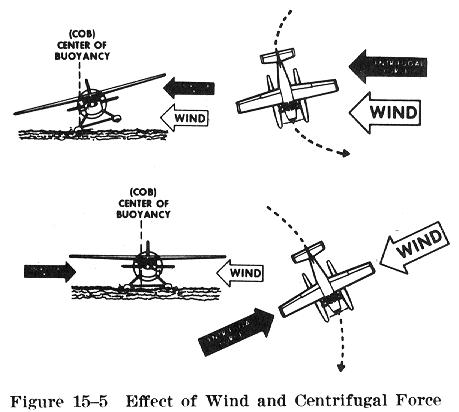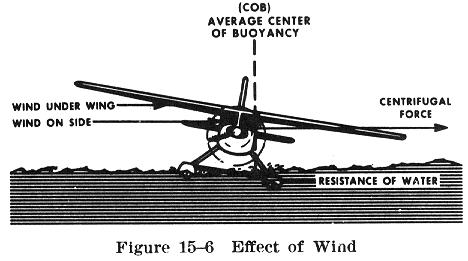
If water rudders have the proper amount of movement, a seaplane can be turned within a radius less than the span of the wing during calm conditions or a light breeze. It will be found that water rudders are usually more effective at slow speeds because they are acting in comparatively undisturbed water. At high speeds, however, the stern of the float churns the adjacent water, thereby causing the water rudder to become less efficient. Furthermore, because of the high speed, the water's impact on the rudders may tend to force them to swing up or retract.
Particular attention should always be given to the risks involved in making turns in a strong wind or at high speeds. Any seaplane will tend to weathervane into a strong wind if the controls are not positioned to prevent it. In a single engine seaplane rudder should be applied as necessary to control the turn while aileron is held into the wind. On twin engine seaplanes this tendency can be overcome through the use of differential power - using a higher setting on the upwind side. The rate at which the seaplane turns when it weathervanes is directly proportional to the speed of the crosswind. When taxiing downwind or crosswind, the seaplane will swing into the wind as soon as the flight controls are neutralized or power is reduced.

During a high speed taxiing turn, centrifugal force tends
to tip the seaplane toward the outside of the turn (Fig. 15-5). Simultaneously,
when turning from a downwind heading to an upwind heading, the wind force
striking the fuselage and the under side of the wing increases the tendency
for the seaplane to lean to the outside of the turn. If an abrupt turn
is made, the combination of these two forces may be sufficient to tip the
seaplane to the extent that the outside wing drags in the water, and may
even tip the seaplane onto its back (Fig. 15-6). Obviously, the further
the seaplane tips, the greater will be the effect of wind, since more wing
area on the windward side is exposed to the wind force.
| When making a turn into the wind from a crosswind condition, the air rudder may be neutralized and the seaplane allowed to weathervane into the wind. If taxiing directly downwind, a turn into the wind may be started by deflecting the air rudder in the same direction that the turn is desired. As soon as the seaplane begins to turn, the rudder should be neutralized; if the wind is strong, some opposite rudder may be needed during the turn. The amount of opposite rudder depends upon the rate at which the seaplane turns. The greater the amount of opposite rudder, the slower the rate of turn. Normally, the power should be reduced to idle when the turn begins because with the |
 |
The seaplane tends to use its center of buoyancy (COB) as a pivot point wherever it may be. Center of buoyancy moves laterally, as well as forward and aft. Each object in water has a point of center of buoyancy. In a twin float installation the effects of wind, power and flight controls are shared by the two floats and the average COB is free to move significantly.
The center of buoyancy (COB), or average point of support, moves aft when the seaplane is placed in a nose up or plowing position (Fig. 15-4). This position exposes to the wind a considerable amount of float and fuselage side area forward of the center of buoyancy. Therefore, when taxiing crosswind in this position, many seaplanes will show a tendency to turn downwind because of the wind force on the exposed area of the float and the fuselage. For this reason it is sometimes helpful to place the seaplane in a nose up position when turning downwind, particularly if the wind velocity is high. Under high wind conditions, the throttle may be used as a turning device by increasing power to cause a nose up position when turning downwind, and decreasing power to allow the seaplane to weathervane into the wind.